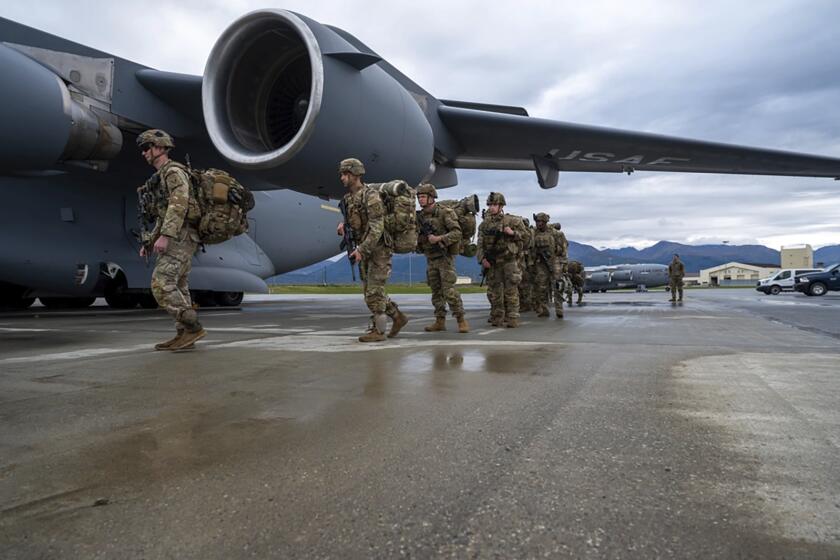Elated Soviets May Plan Earlier Manned Shuttle Flight
The flawless first test flight of the Soviet Union’s new space shuttle early Tuesday opened important new areas of space exploration, Soviet officials said.
Although the Buran spacecraft must still be test-flown by cosmonauts--the short flight on Tuesday of two orbits around the Earth was unmanned--Soviet officials said the shuttle had passed all the crucial tests, notably that of its automated landing system, without any problem.
But so successful were all the tests, the Soviet news agency Tass indicated, that space officials are considering bringing forward the manned flight rather than flying another one or two unmanned missions as planned.
“The spacecraft is only being tested in its automatic mode now,” Tass said. “As a next step, it will be manned by crews of two or four cosmonauts, who will take over some of the chores involved in the control of different systems and assemblies.”
Buran, whose name means snowstorm in Russian, is designed to operate with a crew of two to four and to carry up to six other cosmonauts as well. Crew members have been in training for nearly four years. Officials have given no indication, other than the first half of 1989, when the first manned flight might be launched.
While the spacecraft’s designers feared that problems might develop during the complex descent and the automated, pilotless landing, and Baikonur officials were worried that windy, freezing weather would delay the launching, Tass reported that the flight went completely according to plan.
An earlier attempt to launch the shuttle in late October was canceled when ground equipment failed to function properly, and that followed a series of other, relatively minor disappointments in the Soviet space program.
No one was prouder of the latest achievement, however, than Soviet President Mikhail S. Gorbachev, who told a national agricultural conference in Orel, south of Moscow, that the flight was “a major success for Soviet science and technology.”
“This is one more confirmation that the Soviet Union has vast possibilities for performing any tasks,” he told the conference, which is discussing the country’s most pressing problem--a severe and chronic food shortage.
Buran’s success now puts the Soviet Union into an area of space exploration that the United States has continued to dominate despite the January, 1986, disaster when the shuttle Challenger exploded on takeoff, killing its crew.
Alexander I. Dunayev, the head of the Soviet space agency Glavkosmos, told newsmen last week that several shuttles will be built--a second is already being assembled--and that as many as four flights a year are envisioned with the diverse goals of maintaining or retrieving satellites, ferrying cosmonauts and supplies to orbiting space stations and flying special-purpose missions of up to 30 days.
But Dunayev said that Glavkosmos intends to continue placing most satellites in orbit with the country’s proven--and cost-effective--single-use rockets. “They cost only a tenth as much to use as Buran does,” he said.
U.S. Defense Department officials have, speculatively, added another possible task--the placement of new weapons systems in space, including satellite killers and anti-missile defenses.
No Live Coverage
Films of the space shuttle’s launch and its landing were shown on Soviet television, although there was no live coverage.
A giant Energia rocket, itself new, had carried the 100-ton Buran from the Baikonur space center in Soviet Central Asia to a height of almost 100 miles, where two short bursts of the shuttle’s own small maneuvering rockets freed it and put it into a circular orbit 155 miles above the Earth, according to the official Soviet news agency Tass. Unlike the U.S. shuttle, the Soviet version does not have its own main propulsion system.
After just over two orbits, the spacecraft went through a series of complicated maneuvers to begin its descent, re-enter the Earth’s atmosphere and then land, just as an airplane does, on a specially built runway a few miles from its launch pad in Kazakhstan on schedule, 3 hours and 25 minutes later.
For its designers, the crucial test was of the fully automated control system, which gives ground controllers the ability to operate the shuttle and, they contend, makes it a safer vehicle and gives cosmonauts more time for research.
While Buran looks much like the U.S. space shuttles, the Soviet news media pointed out essential differences--its internal design, its automated landing system and its use of the Energia rocket rather than its own propulsion for its final push from the atmosphere into orbit.
But the U.S. Defense Department argues in its 1988 report Soviet Military Power that the spacecraft was derived almost entirely from U.S. technology.
“By using U.S. propulsion, computer, materials and airframe technology and design, the Soviets were able to produce an orbiter years earlier, and at far less cost, than if they had depended solely on their own technology and engineering,” the Pentagon said.
More to Read
Sign up for Essential California
The most important California stories and recommendations in your inbox every morning.
You may occasionally receive promotional content from the Los Angeles Times.










